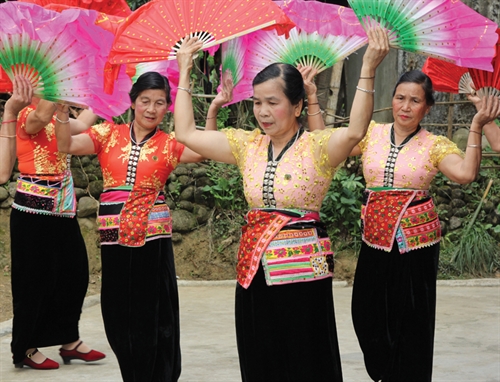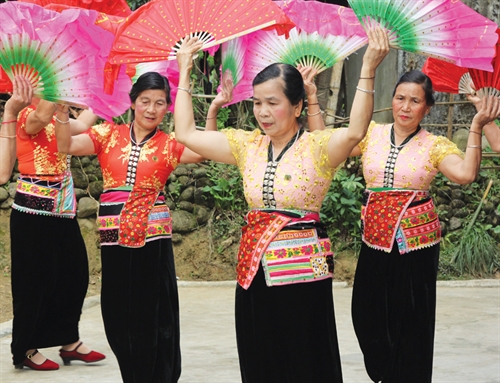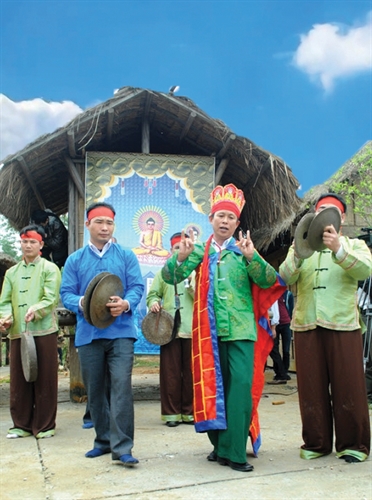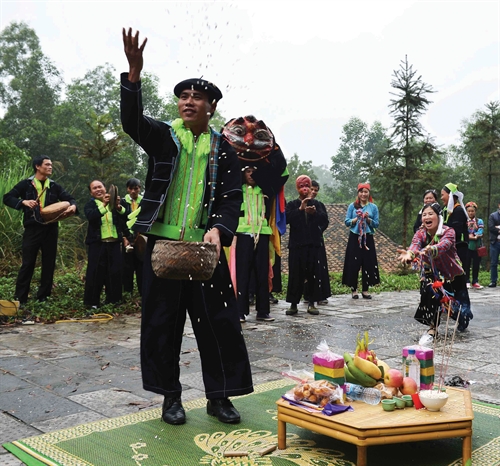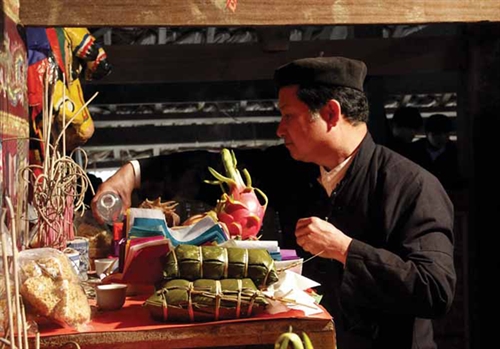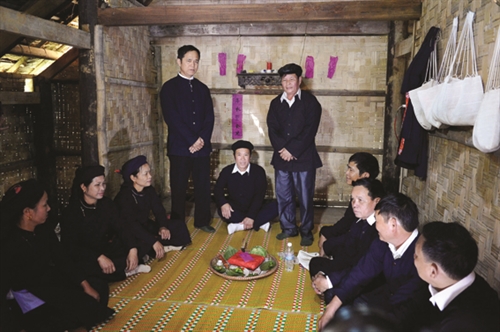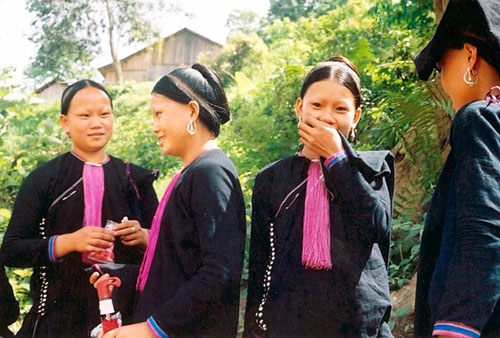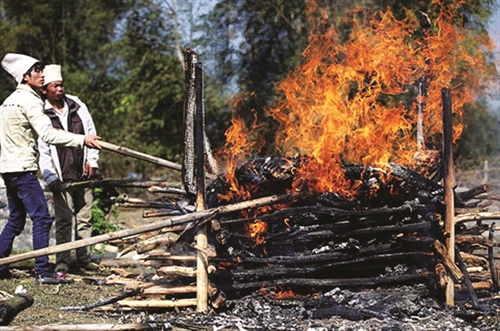Ta Thi Tam
Ethnology Institute
The black Thai are free in love but their marriages are decided by parents and family lines. Lovers who wish to get married will exchange tokens of love like bracelets, rings or embroidered handkerchiefs.
After receiving his girlfriend’s token of love, a man will tell his parents about his future partner, asking for their permission to marry her. The parents then ask a matchmaker to visit the girl’s family to inquire their opinion, bringing wine and betel leaves and areca nuts - the gifts that symbolize the proposal of marriage.
The black Thai choose a matchmaker very carefully because the failure or success of a marriage largely depends on this person who will represent the groom’s family to arrange all wedding affairs. Therefore, the black Thai consider matchmakers third parents after their natural parents and parents-in-law.
A matchmaker should come from a big, happy and well-off family and must be smooth-tongued since he or she will be the only person communicating with the bridal family about the wedding arrangement.
Proposal
Offerings of the proposal include betel leaves and areca nuts, fruit, confectionery, banh chung (square sticky rice cake with pork and green bean fillings) and rice wine, the quantity of each must be two. The convoy going to the bride’s home for the proposal includes the matchmaker, the groom’s parents and paternal and maternal relatives, the total number of whom must be even. While the groom and bride are regarded as children of the two families after the proposal ceremony, the groom’s family still has to pay another five visits to the bride’s before the engagement ceremony. The offerings of these visits are the same as those for the first one but the quantity of each item will increase from four in the second visit, six in the third to twelve in the six visit.
These visits aim to tighten up the relationship between the two families and give time for the bride to make pillows, cushions, blankets and mosquito nets as gifts for her parents- and siblings-in-law before the engagement. The gifts, considered as the bride’s dowry, are also proof of the bride’s talent and diligence.
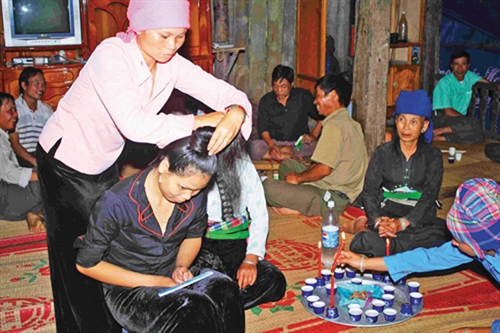 |
| As a custom of the “black” Thai, a bride must have her hair twisted into a “tang cau” (high bun) before going to the husband’s home__Photo: https://baothainguyen.com.vn |
Engagement
The engagement ceremony, which can be held during the last visit of the groom’s family or separately, is for the two families to officially announce the couple’s marital ties.
For this ceremony, the groom’s family should bring a 30-kg pig, a jar of ruou can (rice wine drunk out of a jar through stalks), another two jars of liquor, sticky rice, betel leaves and areca nuts, cigarettes and confectionery. On behalf of the groom’s family, the matchmaker gives these offerings to the bridal family, represented by the bride’s maternal grandfather and aunts and uncles, then discusses with them on the date and time for taking the bride to the groom’s home.
In this ceremony, the two families also discuss and agree on the quantities of wedding presents, the wedding date and the date for the groom to start his matrilocal stay. The groom will have to stay at his wife’s home for between one and three years to show his gratitude to his parents-in-law for raising up his wife. A groom from a poorer family who cannot afford wedding expenses may stay longer as a way to repay his parents-in-law’s wedding expenses. A groom who stays with his wife’s family for five years may receive part of property from his parents-in-law when the couple moves out to live separately.
Although having been considered as a son in the bridal family during his matrilocality, the groom is not supposed to have a meal together with his mother- and sisters-in law, and particularly to sleep with his wife because he is not an official family member yet.
If the wedding is not held within one month after the engagement ceremony, the groom’s family is supposed to visit the bride’s once a month exactly on the engagement date to show their alliance to the community.
The Thai community acknowledges the customs of bride kidnapping for poor grooms who cannot afford a wedding. The bride kidnapping is not real as it is consented by the two families. In fact, the bride will prepare necessary clothes and personal articles before “escaping” with the groom. When the couple arrives home, the groom’s family makes a tray of offerings to their ancestors to inform them of the new member and concurrently sends a representative to the bridal family to excuse for the kidnapping, bringing betel leaves and areca nuts, liquor and a chicken as wedding presents. The bridal family will ask for a nominal fine in silver or money. After that, the bridal family holds a party to invite relatives to officially recognize their daughter’s marriage.
Paying wedding presents
The ceremony to pay wedding presents not only marks the final step to a marriage but also shows the wealth of the groom’s family.
In this ceremony, the groom’s family will give the wedding presents as exacted by the bride’s, which normally include five bars of silver, three jars of ruou can, one or two pigs, two baskets of sticky rice, 40 bamboo cylinders containing rice, 40 buffalo horn-shaped sticky rice cakes, five jars of rice wine, one basket of betel leaves and areca nuts, and cash as asked by the bridal family. The quantities of these wedding presents may increase or decrease depending on the length of the groom’s matrilocal stay.
After receiving the wedding gifts, the bridal family shows its hospitality by inviting the groom’s family to have a party with ruou can, sticky rice and meat.
Wedding
On the wedding day, the matchmaker, the groom’s father and four young men, four young women, four old men and women, and some others bring rice, ruou can, buffalo horn-shaped cakes, betel leaves and areca nuts, a pig and cooking utensils to the bridal family. After the matchmaker shows the offerings to the bridal family, the groom’s family themselves prepare a feast from the offerings for the two families to enjoy. After the feast, they all will play gongs and drums and dance to cheer for the couple.
To take the bride to his home, the groom is escorted to the bridal family. Along the way to his bride’s house, the groom and his companions must overcome three obstacles which are strings stretched across the road by the bridal family. To pass these obstacles, the groom family must sing a song telling the reason for their visit.
Before the bride leaves for her husband’s home, a marriage tie ceremony is conducted by the matchmaker in the bride’s room. Offerings include two trays of sticky rice, chicken meat, two boiled chicken eggs, some sugarcane cutlets, and a jar of ruou can with two stalks tied with pieces of white jute thread. After the matchmaker recites prayers, asking gods to recognize the marriage of the couple and bless them, members of both families tie pieces of white thread around the wrists of the bride and groom to wish them lifelong love, health, happiness and prosperity. The couple then eat and drink together in a customary way.
A woman then wears a necklace and earrings for the bride, coils her hair into a bun and pins a brooch through it, which means the bride is now married.
Before taking his wife home, the groom wears a necklace or some silver bracelets on his mother-in-law, and offers her a jar of ruou can, a dish of betel leaves and areca nuts and five rolls of silk fabric to show his respect and gratitude to her.
The bride is escorted to her husband’s home at sunrise which is believed by the Thai to be the best time of the day. Heading the procession is the matchmaker, followed by the bride and groom, bridesmaids and groomsmen, and relatives and friends of the couple.
Before entering the groom’s house, the bride washes her feet in a basin of “golden” and “silver” water placed at the foot of the stairs to get rid of evil spirits that may follow her to disturb the young couple’s happiness. The mother-in-law receives the bride and leads her to the bridal room for makeup again before meeting guests while other members of the groom’s family receive her parents and relatives.
A tray of offerings, which includes a pig head together with a front leg and innards, sticky rice, boiled meat, ruou can and betel leaves and areca nuts, is placed in front of the ancestor altar together with a new shirt of the bride, in a ritual to recognize the bride as a new family member. The matchmaker recites prayers to inform the ancestors of the new daughter-in-law and ask for their protection for her to have good health and soon give birth to a son. After that, the bride kowtows five times in front of the altar, officially becoming a daughter of her husband’s family.
After this ceremony, the bride, accompanied by the groom and a representative of his family, comes to meet every relative of the groom’s family as the final formality of the wedding.-
